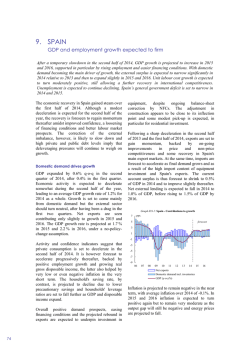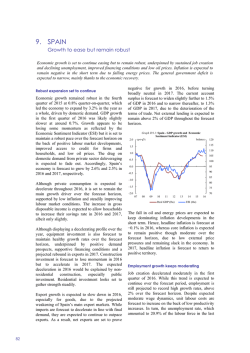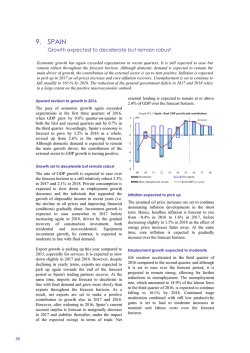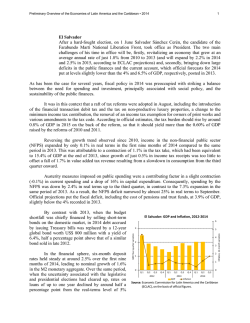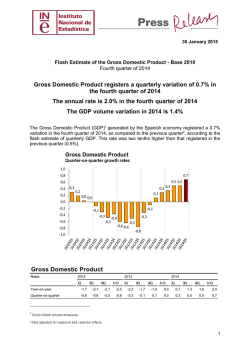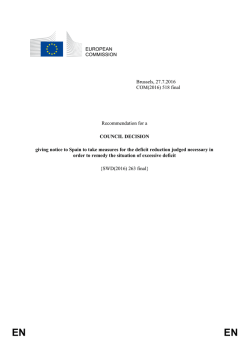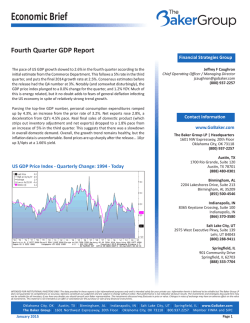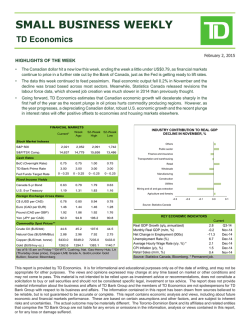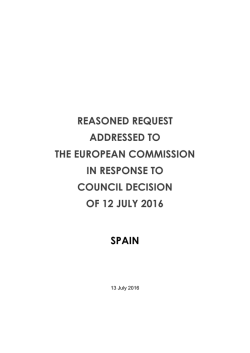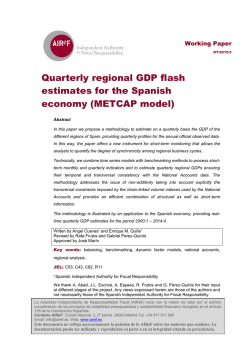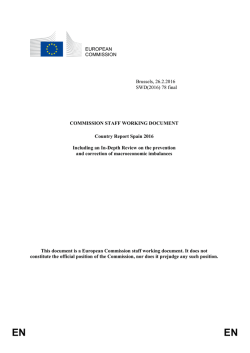
9. SPAIN
9. SPAIN Rising growth on the back of domestic demand Spain’s economic growth is set to pick up as domestic demand benefits from an improving labour market, easier financing conditions, greater confidence and lower oil prices. Net exports, by contrast, are expected to dampen growth, although this effect will gradually diminish this year and next, as Spain’s competitiveness improves. At the same time, the government deficit should continue to narrow. After three years of recession, Spain’s economy began to grow again in 2014 and seems to be gathering momentum as labour market prospects improve, financial conditions loosen, confidence strengthens, economic uncertainty fades and energy prices fall. These factors are expected to sustain growth over the forecast horizon, despite the continued drag from high levels of private and public indebtedness and deleveraging. The speed of the ongoing external adjustment, however, is likely to slow. including residential investment, is expected in 2015. Graph II.9.1:Spain - Real GDP growth and contributions pps. 7 forecast 5 3 1 -1 -3 -5 Domestic demand keeps driving growth After having expanded by 0.5% q-o-q in both the second and the third quarters of 2014, economic activity is expected to have gained further momentum in the last quarter, leading to an overall GDP growth of 1.4% for 2014 as a whole. GDP growth is projected to reach 2.3% in 2015 and 2.5% in 2016, mainly driven by domestic demand. The sizeable drag from the external sector observed over the first half of 2014 should narrow, and net exports are expected to prove slightly negative for growth in 2015 and turn neutral in 2016. Recent hard data on activity and soft data from confidence indicators both suggest that private consumption remained quite resilient in the last quarter of 2014. Such resilience is expected to persist as a result of robust employment growth and rising real gross disposable income, which should also benefit from falling price levels throughout most of 2015 and low inflation thereafter. Lower precautionary savings are forecast to reduce the households' saving rate further in the short term. Households' leverage ratios are set to keep falling as GDP and disposable income expand. Positive demand prospects, easing financing conditions and the projected rebound in exports are expected to underpin investment in equipment, despite the ongoing balance-sheet correction of non-financial corporations. After seven years of adjustment, a modest pick-up in construction, -7 -9 07 08 09 10 11 12 13 14 15 16 Net external demand Domestic demand incl. inventories GDP (y-o-y%) Exports are expected to accelerate during 2015, backed by continued improvements in price and non-price competitiveness and the projected recovery in Spain's main export markets. At the same time, after the sharp expansion in 2014, imports are forecast to moderate slightly to align with long-term final demand elasticities. The current account is set to register a small deficit of 0.1% of GDP in 2014, but this should turn into surpluses of some 0.5% thereafter, also due to the impact of the decline in oil prices. In turn, net external lending is expected to narrow sharply in 2014, to 0.3% of GDP, before rising again to around 1.0% of GDP as of 2015. Inflation is expected to have averaged -0.2% in 2014 and will remain negative in the short term, also as a result of falling oil prices. Hence, inflation is foreseen to fall to -1.0% in 2015. In 2016, however, inflation is forecast to turn positive, but remain low, as the economy’s output gap remains very negative. Sustained employment growth Having peaked at 26.9% of the workforce in the first quarter of 2013, the unemployment rate declined to 23.7% in the fourth quarter of 2014. 77 European Economic Forecast, Winter 2015 Job creation gathered steam in the second half of 2014, while the size of the labour force continued to contract. These positive trends are expected to intensify over the forecast horizon, helped by continued wage moderation and only modest increases in nominal unit labour costs. With the labour force contraction expected to fade slowly, unemployment is forecast to fall to 20.7% in 2016. The fall in oil prices and the monetary policy interventions by the ECB could translate into higher growth and less negative inflation than assumed in this forecast, as they could push private consumption and investment further. Continued consolidation helped by recovery Recent data indicates that public finances continued improving in 2014, with the general government deficit in the first three quarters of the year reaching 3.6% of GDP, 0.6 pp. lower than last year (net of bank recapitalisations). All in all, the deficit for the year as a whole is expected to narrow to around 5.6% of GDP, down from 6.3% of GDP in 2013, net of bank recapitalisations in both years. Going forward, the reduction of the deficit is relying mostly on the improving economic outlook. The government deficit is expected to fall to around 4.5% and 3.7% of GDP in 2015 and 2016, respectively, despite the impact from recently implemented tax cuts. The reduction in the deficit is held back by subdued nominal GDP growth, which is acting as a drag on revenue developments. Risks stem from uncertainty regarding the impact of the tax reform on revenues, contingent liabilities in the motorway sector and implementation risks in an election year. While pension expenditures are forecast to continue rising, falling unemployment should limit the growth of social transfers in the near future. Thanks to lower interest rates, interest expenditure growth should moderate over the forecast horizon. Spain's structural deficit is expected to widen by about ¼ pp. per year in 2015 and 2016, reaching 2¾% in 2016. Still sizable budget deficits and low nominal GDP growth are expected to push the public debt ratio above 100% in 2015 and to 102.5% in 2016. Table II.9.1: Main features of country forecast - SPAIN 2013 GDP Private Consumption Public Consumption Gross fixed capital formation of which: equipment Exports (goods and services) Imports (goods and services) GNI (GDP deflator) Contribution to GDP growth: Annual percentage change bn EUR Curr. prices % GDP 95-10 2011 2012 2013 2014 2015 2016 1049.2 100.0 2.8 -0.6 -2.1 -1.2 1.4 2.3 2.5 610.3 58.2 2.5 -2.0 -2.9 -2.3 2.3 2.7 2.6 204.2 19.5 4.1 -0.3 -3.7 -2.9 0.5 0.3 0.1 194.3 18.5 3.4 -6.3 -8.1 -3.8 3.2 4.7 5.2 60.6 5.8 4.5 0.9 -9.1 5.3 13.4 7.9 8.7 331.1 31.6 5.2 7.4 1.2 4.3 4.5 5.4 6.0 295.3 28.1 5.8 -0.8 -6.3 -0.5 7.7 6.9 6.7 1041.9 99.3 2.8 -0.9 -1.2 -1.1 0.7 2.9 2.7 3.1 -2.7 -4.2 -2.7 2.0 2.6 2.6 0.0 0.0 -0.1 0.0 0.2 0.0 0.0 -0.3 2.1 2.2 1.4 -0.8 -0.3 0.0 2.0 -2.6 -4.4 -3.3 0.8 1.8 2.0 13.8 21.4 24.8 26.1 24.3 22.5 20.7 3.5 0.9 -0.6 1.7 0.5 0.7 0.8 2.7 -1.1 -3.0 -0.4 -0.2 0.2 0.3 -0.3 -1.2 -3.2 -1.1 0.5 0.0 -0.7 11.4 11.9 9.5 10.4 9.0 9.3 9.4 3.1 0.1 0.2 0.7 -0.7 0.2 1.0 2.9 3.1 2.4 1.5 -0.2 -1.0 1.1 0.3 -4.3 -0.9 1.4 -0.7 2.4 -0.4 -5.5 -4.1 -2.7 -1.2 -2.0 -1.7 -1.9 -4.5 -3.3 -0.4 1.5 -0.1 0.6 0.5 -3.8 -2.9 0.1 2.1 0.3 1.0 0.9 -2.6 -9.4 -10.3 -6.8 -5.6 -4.5 -3.7 -3.0 -6.4 -6.5 -2.7 - -2.3 -2.4 -2.7 - -6.2 -3.5 -2.2 - -2.1 -2.3 -2.7 52.5 69.2 84.4 92.1 98.3 101.5 102.5 Domestic demand Inventories Net exports Employment Unemployment rate (a) Compensation of employees / f.t.e. Unit labour costs whole economy Real unit labour cost Saving rate of households (b) GDP deflator Harmonised index of consumer prices Terms of trade goods Trade balance (goods) (c) Current-account balance (c) Net lending (+) or borrowing (-) vis-a-vis ROW (c) General government balance (c) Cyclically-adjusted budget balance (c) Structural budget balance (c) General government gross debt (c) (a) Eurostat definition. (b) gross saving divided by gross disposable income. (c) as a percentage of GDP. 78
© Copyright 2024
